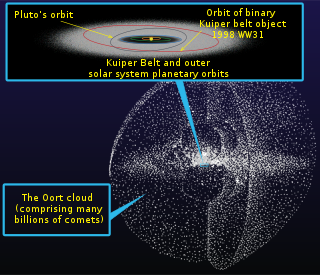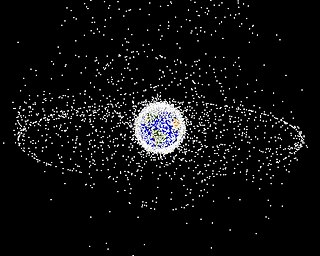Extraterrestrial life, alien life, or colloquially simply aliens, is life which does not originate from Earth. No extraterrestrial life has yet been conclusively detected. Such life might range from simple forms such as prokaryotes to intelligent beings, possibly bringing forth civilizations that might be far more advanced than the human species. The Drake equation speculates about the existence of sapient life elsewhere in the universe. The science of extraterrestrial life is known as astrobiology.

The Fermi paradox is the discrepancy between the lack of conclusive evidence of advanced extraterrestrial life and the apparently high likelihood of its existence. As a 2015 article put it, "If life is so easy, someone from somewhere must have come calling by now."

Space colonization is the use of outer space for colonization, such as permanent habitation, exploitation or territorial claims. Extraterrestrial colonization is its broader form, including the use of celestial bodies, other than Earth, for colonization.

Alien invasion or space invasion is a common feature in science fiction stories and film, in which extraterrestrial lifeforms invade the Earth to exterminate and supplant human life, enslave it, harvest people for food, steal the planet's resources, or destroy the planet altogether. It can be considered as a science-fiction subgenre of the invasion literature, expanded by H. G. Wells's seminal alien invasion novel The War of the Worlds, and is a type of "first contact" science fiction.

A space settlement is a settlement in outer space, sustaining more extensively habitation facilities in space than a general space station or spacecraft. Possibly including closed ecological systems, its particular purpose is permanent habitation.
Extraterrestrial intelligence (ETI), a subset of non-human intelligence (NHI), refers to hypothetical intelligent extraterrestrial life. No such life has ever been proven to exist in the Solar System except for humans on Earth, and its existence in other star systems is still speculative. The question of whether other inhabited worlds might exist has been debated since ancient times. The modern form of the concept emerged when the Copernican Revolution demonstrated that the Earth was a planet revolving around the Sun, and other planets were, conversely, other worlds. The question of whether other inhabited planets or moons exist was a natural consequence of this new understanding. It has become one of the most speculative questions in science and is a central theme of science fiction and popular culture.
Xenoarchaeology, a branch of xenology dealing with extraterrestrial cultures, is a hypothetical form of archaeology that exists mainly in works of science fiction. The field is concerned with the study of the material remains to reconstruct and interpret past life-ways of alien civilizations. Xenoarchaeology is not currently practiced by mainstream archaeologists due to the current lack of any material for the discipline to study.
The zoo hypothesis speculates on the assumed behavior and existence of technologically advanced extraterrestrial life and the reasons they refrain from contacting Earth. It is one of many theoretical explanations for the Fermi paradox. The hypothesis states that extraterrestrial life intentionally avoids communication with Earth to allow for natural evolution and sociocultural development, and avoiding interplanetary contamination, similar to people observing animals at a zoo. The hypothesis seeks to explain the apparent absence of extraterrestrial life despite its generally accepted plausibility and hence the reasonable expectation of its existence. A variant on the zoo hypothesis suggested by the former MIT Haystack Observatory scientist John Allen Ball is the "laboratory" hypothesis, in which humanity is being subjected to experiments, with Earth serving as a giant laboratory.
Alien languages, i.e. languages of extraterrestrial beings, are a hypothetical subject since none have been encountered so far. The research in these hypothetical languages is variously called exolinguistics, xenolinguistics or astrolinguistics. A group of prominent linguists and animal communication scientists, including Noam Chomsky, have examined such hypothetical languages in the book Xenolinguistics: Towards a Science of Extraterrestrial Language, edited by astrobiologist Douglas Vakoch and linguist Jeffrey Punske. The question of what form alien languages might take and the possibility for humans to recognize and translate them has been part of the linguistics and language studies courses, e.g., at the Bowling Green State University (2001).

An extraterrestrial or alien is a lifeform that did not originate on Earth. The word extraterrestrial means "outside Earth". The first published use of extraterrestrial as a noun occurred in 1956, during the Golden Age of Science Fiction.

Proposed Studies on the Implications of Peaceful Space Activities for Human Affairs, often referred to as "the Brookings Report", was a 1960 report commissioned by NASA and created by the Brookings Institution in collaboration with NASA's Committee on Long-Range Studies. It was submitted to the House Committee on Science and Astronautics of the United States House of Representatives in the 87th United States Congress on April 18, 1961.

In ufology, Nordic alien is the name given to alleged humanoid extraterrestrials, purported to come from the Pleiades, who resemble Nordic-Scandinavians. Alleged contactees describe them as being 6–7 ft (1.8–2.1 m) tall with long blond hair, blue eyes, and fair skin. George Adamski is credited with being among the first to claim contact with Nordic aliens in the mid-1950s, and scholars note that the mythology of extraterrestrial visitation from beings with features described as "Aryan" often include claims of telepathy, benevolence, and physical beauty.

Freeman Dyson proposed that trans-Neptunian objects, rather than planets, are the major potential habitat of life in space. Several hundred billion to trillion comet-like ice-rich bodies exist outside the orbit of Neptune, in the Kuiper belt and Inner and Outer Oort cloud. These may contain all the ingredients for life, including significant amounts of deuterium and helium-3. Since Dyson's proposal, the number of trans-Neptunian objects known has increased greatly.
The interdimensional hypothesis is a proposal that unidentified flying object (UFO) sightings are the result of experiencing other "dimensions" that coexist separately alongside our own in contrast with either the extraterrestrial hypothesis that suggests UFO sightings are caused by visitations from outside the Earth or the psychosocial hypothesis that argues UFO sightings are best explained as psychological or social phenomenon.

Human presence in space is the direct and mediated presence or telepresence of humans in outer space and in a broader sense also on any extraterrestrial astronomical body. Human presence in space, particularly through mediation, can take many physical forms from space debris, uncrewed spacecraft, artificial satellites, space observatories, crewed spacecraft, art in space, to human outposts in outer space such as space stations.
A post-detection policy (PDP), also known as a post-detection protocol, is a set of structured rules, standards, guidelines, or actions that governmental or other organizational entities plan to follow for the "detection, analysis, verification, announcement, and response to" confirmed signals from extraterrestrial civilizations. Though no PDPs have been formally and openly adopted by any governmental entity, there is significant work being done by scientists and nongovernmental organizations to develop cohesive plans of action to utilize in the event of detection. The most popular and well known of these is the "Declaration of Principles Concerning Activities Following the Detection of Extraterrestrial Intelligence", which was developed by the International Academy of Astronautics (IAA), with the support of the International Institute of Space Law. The theories of PDPs constitute a distinct area of research but draw heavily from the fields of SETI, METI, and CETI.
The cultural impact of extraterrestrial contact is the corpus of changes to terrestrial science, technology, religion, politics, and ecosystems resulting from contact with an extraterrestrial civilization. This concept is closely related to the search for extraterrestrial intelligence (SETI), which attempts to locate intelligent life as opposed to analyzing the implications of contact with that life.

A space habitat in a basic sense is any facility providing shelter and fulfilling habitational purposes in outer space. It is not to be confused with an extended space settlement, an arrangement of or infrastructure for multiple habitation facilities, in the sense of a space settlement. Space stations or theoretical extraterrestrial stations, such as a Moonbase or Mars habitat, include or are basic space habitats.
The UK Centre for Astrobiology was set up at the University of Edinburgh in 2011 by Charles Cockell. It was set up as a UK node, formally affiliated as an international partner with the NASA Astrobiology Institute (NAI) alongside other national nodes until the NAI's dissolution in 2019. It was established as a virtual centre to sit at the interdisciplinary boundary of planetary sciences/astronomy and biological/earth sciences investigating numerous aspects of life in the universe, specifically 'how habitable worlds form in the Universe and how life emerges, proliferates and leaves traces on these worlds' as well as engaging in work on the robotic and human exploration of space and in space ethics, philosophy and governance.

Astrosociology,sociology of outer space, or sociology of the universe is the study of the relationship between outer space, extraterrestrial places, and the wider universe and society. It is an interdisciplinary study between space-related sciences and sociology that seeks to understand the impact of human society outside our current planetary system.